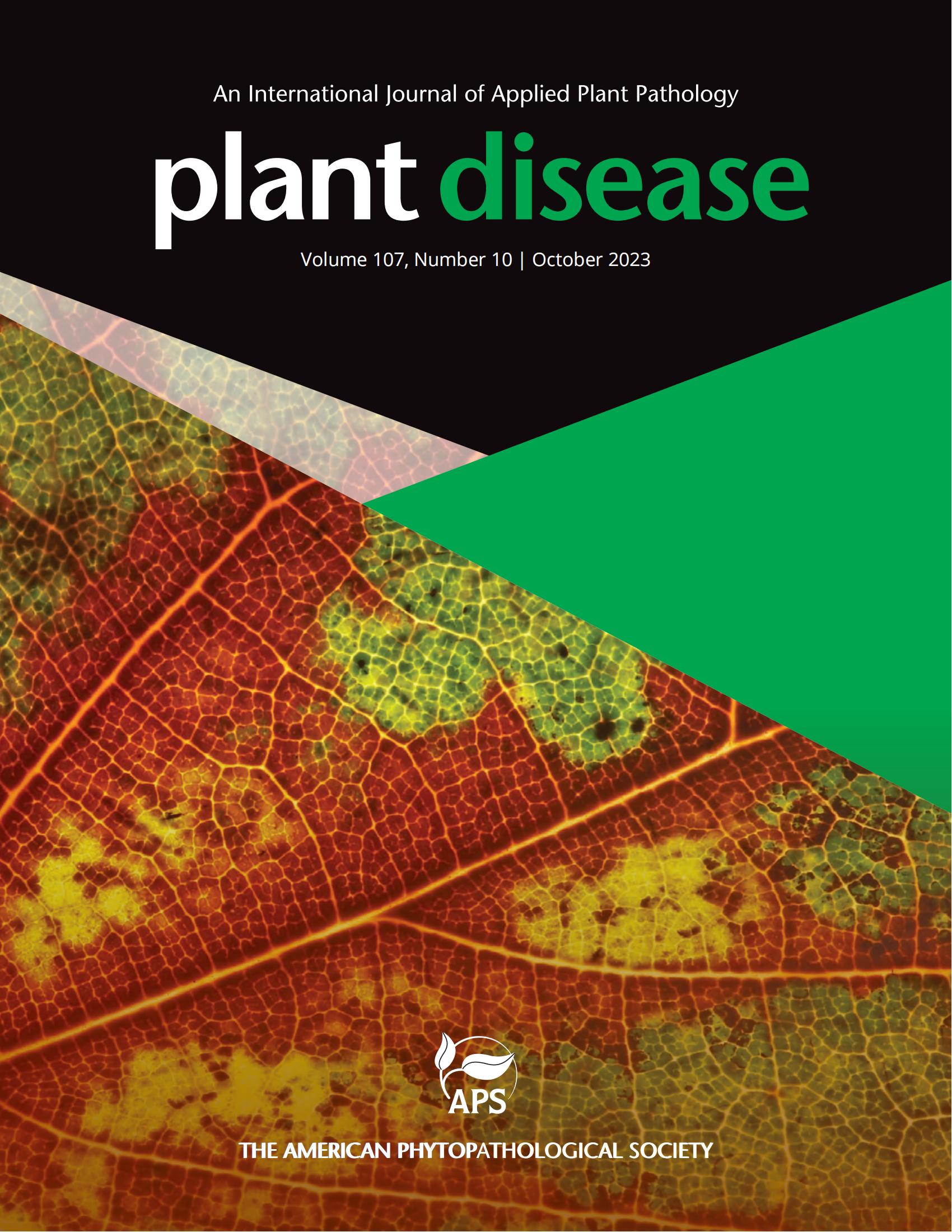西班牙引起扁桃叶斑病的交替孢复菌首次报道。
摘要
2022年,西班牙是世界第三大杏仁生产国(FAOSTAT, 2022)。从2021年夏季开始,杏仁树(Prunus dulcis [Mill])的叶缘中心呈灰色的褐色叶斑高发,并伴有严重的落叶。[D.韦伯)。Campos de Hellín地区(西班牙卡斯蒂利亚-拉曼查)受影响面积约200公顷。受影响果园以高密度种植和灌溉为主。该病害影响了目前的栽培品种‘Laureanne’和‘Penta’。在一些果园中,在收获前观察到高达90%的落叶。收集有症状的叶片,用1% NaOCl浸泡2 min,表面消毒,然后用无菌蒸馏水冲洗,风干。叶组织的小碎片(约。从坏死灶边缘切下5 mm),用链霉素(PDAS)涂在马铃薯葡萄糖琼脂上。28℃黑暗培养1周后,分离真菌在新的PDAS上传代培养。采用单菌丝尖端分离方法从不同叶片中分离得到A10和A12两个菌株。分离株最初呈灰白色,后来变暗为黑色或橄榄绿,边缘较浅。分生孢子为浅棕色,倒卵形至椭圆形,由横隔和纵隔分隔,两株菌株的分生孢子尺寸为10-52 × 6-20µm (n = 100)。形态特征类似于Alternaria属的小孢子群(Simmons 2007)。利用引物对ITS1/ITS4 (White et al. 1990)、GPD1/GPD2 (Berbee et al. 1999)、RPB2- 5f2 /RPB2- 7cr (Sung et al. 2007)扩增ITS rDNA、GAPDH、RPB2和TEF1区域的基因序列。Liu et al. 1999)和EF1-728F/EF1-986R (Carbone & John 1999)。分离株A10和A12的PCR产物测序并录入NCBI GenBank数据库,登录号为PQ554678-79和PQ559657-62。使用IQ-TREE v1.6.12 (Minh et al., 2020)对串联基因序列进行最大似然系统发育分析。分析表明,分离物与A. alternata complex关系密切(Woudenberg et al. 2015)。分离株A10和A12分别在有皮下针伤的叶片和未受伤的叶片上进行致病性试验。以5·104个分生孢子/ml的水悬浮液喷施于1年生健康盆栽杏树(cv。‘Laureanne’,n = 5),对照植株喷洒无菌水。接种后,用塑料袋包住植株,在黑暗中保存两天。生长室条件为25±2°C, 70±25% RH, 12 h光周期。接种8天后,接种植株出现了与最初观察到的症状相似的症状。两个分离株表现出相似的攻击性。此外,接种29 d后,叶伤处理和无叶伤处理的叶片脱落率均接近40%。从病变中分离出来的真菌显示出与接种的真菌相同的形态和序列,证实了科赫的假设。据我们所知,这是西班牙第一次报道在杏树上发生叶斑病。考虑到西班牙杏树栽培的重要性及其在集约灌溉栽培面积上的预期增长,有必要加强对这种新病原体的关注。In 2022, Spain was the third largest almond-producing country in the world (FAOSTAT, 2022). Starting the summer of 2021 a high incidence of brown leaf spots with grey centre on leaf margin accompanied by severe defoliation was recorded on almond trees (Prunus dulcis [Mill.] D. Webb). The affected area was about 200 ha in the region of Campos de Hellín (Castilla-La Mancha, Spain). The affected orchards were characterized by high planting density and irrigation. The disease affected the cultivars present, 'Laureanne' and 'Penta'. In some orchards, up to 90% defoliation was observed before harvest. Symptomatic leaves were collected and surface sterilized by inmersion in 1% NaOCl for 2 min, followed by rinsing in sterile distilled water, and air-drying. Small fragments of leaf tissue (approx. 5 mm) were cut from the margins of necrotic lesions and plated on potato dextrose agar with streptomycin (PDAS). The plates were incubated at 28°C for one week in the dark, then the fungal isolate was sub-cultured on new PDAS. Two individual strains (A10 and A12) were obtained from different leaves by single hyphal tip isolation. The isolates initially appeared greyish-white, later darkening to black or olive-green with a lighter border. Conidia were light brown and obclavate to elliptical, divided by transverse and vertical septa and measured 10-52 × 6-20 µm for both isolates (n = 100). Morphological characteristics resembled those of the small-spored group of the Alternaria genus (Simmons 2007). Gene sequences of ITS rDNA, GAPDH, RPB2, and TEF1 regions were amplified using primer pairs ITS1/ITS4 (White et al. 1990), GPD1/GPD2 (Berbee et al. 1999), RPB2-5F2/RPB2-7cR (Sung et al. 2007; Liu et al. 1999) and EF1-728F/EF1-986R (Carbone & John 1999) respectively. The PCR products from isolates A10 and A12 were sequenced and submitted to NCBI GenBank database with the accession numbers of PQ554678-79 and PQ559657-62. A maximum likelihood phylogenetic analysis based on the concatenated gene sequences was performed using IQ-TREE v1.6.12 (Minh et al., 2020). The analysis showed that the isolates were closely related to A. alternata complex (Woudenberg et al. 2015). The pathogenicity test were carried out with isolates A10 and A12 in two trials, one on leaves with hypodermic needle wounds and one on unwounded leaves. Inoculation was carried out by spraying a water suspension of 5·104 conidia/ml on leaves of healthy one-year-old pot-grown almond plants (cv. 'Laureanne', n = 5), control plants were sprayed with sterile water. Following inoculation, plants were covered with a plastic bag and keep in darkness for two days. Growth chamber conditions were 25 ± 2°C, 70 ± 25 % RH and 12-h photoperiod. Symptoms similar to those initially observed, appeared on the inoculated plants 8 days after inoculation. Both isolates showed similar aggressiveness. In addition, 29 days after inoculation, defoliation rates close to 40% were achieved with no difference between the trials with and without leaf wounds. The fungus isolated from the lesions showed the same morphology and sequences as the inoculated ones, confirming Koch's postulates. To our knowledge, this is the first report of A. alternata as a causal agent of leaf spot disease on almond trees in Spain. Considering the importance of almond tree cultivation and its expected increase in the area under intensive and irrigated cultivation in Spain, it is essential to pay more attention to this new pathogen.

 求助内容:
求助内容: 应助结果提醒方式:
应助结果提醒方式:


